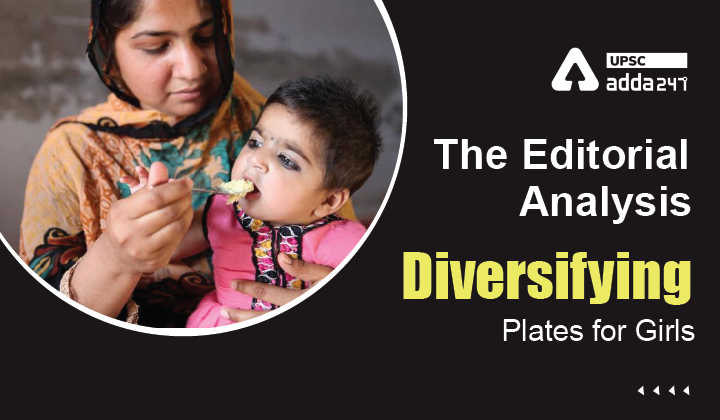Table of Contents
Relevance
- GS 2: Welfare schemes for vulnerable sections of the population by the Centre and States.
Girls need more nutrition
- Girls face more physiological demands than boys and thus require a higher intake of macro and micro nutrients.
- Susceptibility of adolescent girls to anaemia is 40% compared to boys at 18%.
- This is why promoting dietary diversity is crucial during adolescence, as dietary habits are in the formative stage and thus can be continued in adult life.
Why to focus on girls?
- The National Family Health Survey (NFHS)-5 data show an increase in anaemia among adolescent girls by 5% when compared to NFHS-4.
- Similarly, the Comprehensive National Nutrition Survey 2019 shows that even before the pandemic, consumption of diverse food groups among adolescents was low.
- The fallout of COVID-19 has further worsened dietary diversity, especially of women, adolescents and children.
- The lockdowns also led to the loss of mid-day meals and interruptions in Weekly Iron Folic Acid Supplementation (WIFS) and nutrition education in schools for adolescent girls.
- This was compounded by challenges in providing nutrition services to out-of-school adolescent girls which further increased their vulnerability to poor nutrition outcomes.
Recommendations
- Along with continued service delivery of WIFS, the government’s health and nutrition policies need to emphasise on strong compliance to diverse diets and physical activities.
- This includes locally sourced fruits and vegetables, seasonal diets, and the inclusion of millets.
- We need to promote good nutrition among adolescents through Nutri-Smart schools (building kitchen gardens in schools).
- we need to think beyond schools. Young girls need to be equipped with accurate information about adequate and appropriate diets so that they can act as change agents for their families, community, and peer groups.
- Further, food diversification is required to be complemented with reformative steps such as the recent amendment of increasing the legal age of marriage for women from 18 years to 21 years.
- Currently, 80% of adolescents suffer ‘hidden hunger’ due to micro nutrient deficiencies. The trend is more prevalent in girls as they already suffer multiple nutritional deprivations. We need to strengthen our policy initiatives to address deficiencies of not just iron and folic acid, but also vitamin B12, vitamin D, and zinc.
- The design of POSHAN Abhiyan needs to be inclusive of the growing risk of non-communicable diseases and obesity among adolescents.
- Since over 10% of adolescents are overweight in 12 States of India, strict action plans need to be devised against the sale and advertisement of unhealthy foods and beverages.
Read current affairs for UPSC





 TSPSC Group 1 Question Paper 2024, Downl...
TSPSC Group 1 Question Paper 2024, Downl...
 TSPSC Group 1 Answer key 2024 Out, Downl...
TSPSC Group 1 Answer key 2024 Out, Downl...
 UPSC Prelims 2024 Question Paper, Downlo...
UPSC Prelims 2024 Question Paper, Downlo...





